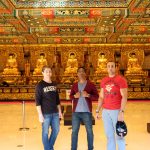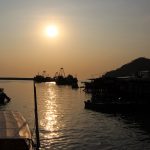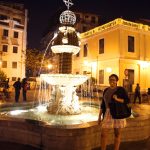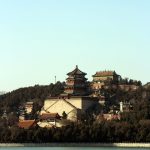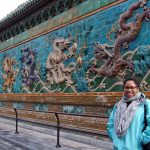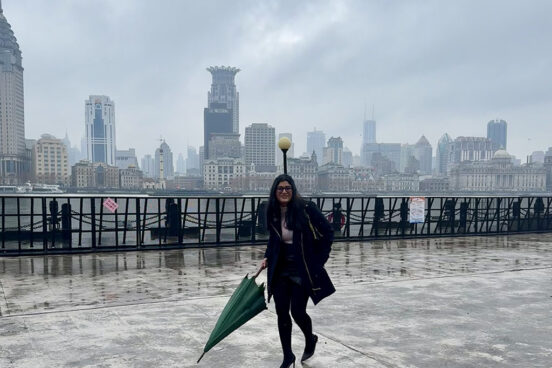Duke MMS Student Blog

Travel in China Provides Cultural Insight—And a Lot of Fun

A curious fact I learned soon after arriving in China is that what non-Chinese always refer to as the Chinese New Year, is actually called the Spring Festival by locals. The spring festival is a two-week period in which everyone goes back to their home towns to celebrate with family.
As such, we had two weeks off from school, which many MMS: DKU students used to travel in China and around East Asia. Personally, I went to Hong Kong, Macau, Guangzhou and Beijing with some fellow classmates, and spent the actual New Year’s Eve (February 18) in Beijing. Here are some highlights:
Hong Kong
I started off by going to Hong Kong for a few days. Potter Weng, one of our Chinese classmates and president of our class, came with us on the first part of the trip before returning to Shanghai to celebrate the Chinese New Year’s Eve with his family.

We not only had a blast together in Hong Kong, but we were able to learn a lot about the local culture and taste some traditional Cantonese dim sum and hot pot, per his recommendation. It was an amazing opportunity to better understand the influence the British had on the area and see the similarities and differences between main land China and Hong Kong.
With the Spring Festival arriving, similar to in China, we saw a lot of red (the color for good luck) and decorative goats (since 2015 is the year of the goat). Some highlights of the trip were going to the Victoria Peak to see the city skyline at the moment the lights turned on at night while pushing around with other tourists to get the perfect picture, going to see the Big Buddha, stopping by Tai-O Village—a water village in Hong Kong—and taking a boat trip to see the white Chinese dolphin!
Like in a previous post about my first impressions of China, I once again was shown that the world is very small. Walking around the antiques street in Hong Kong, I found a very old Argentinean peso bill that reminded me of home! All in all, it was a fantastic cultural immersion experience and we were able to appreciate some amazing views!
Macau
From Hong Kong, we took a quick ferry to Macau, another small island where we were able to see the Portuguese influence on the Chinese culture. I fell in love with Macau, partially because it reminded me a lot of growing up in Brazil, as it too was a Portuguese colony for a while. The historical center was beautiful to walk around, and I was able to use what I learned visiting Ouro Preto in Brazil, to explain to my friend and classmate, Symone Bullock, a little about the way the city was formed with the church in the center at the top of the hill. After a day of exploring the small, yet very cute, city center we headed back to the hotel to get ready for the night. After all, they do say that Macau is the Las Vegas of Asia.
Guangzhou

From Macau we literally walked through immigration to enter mainland China again, and then took a short bus to Guanghzou. We were not there for long as our flight to Beijing was leaving the next morning, but we did get to taste traditional food from South China and see the 17-story Chigang Pagoda and the Guangzhou TV Tower colorfully lit at night.
February 18 was the Chinese New Year’s Eve, so at the Guangzhou airport we parted ways, with Potter going back to Shanghai with his family, and the rest of us heading to Beijing. At the airport, Potter gave each one of us a red envelope, which is part of the Chinese tradition during the Spring Festival.
Beijing
As soon as we arrived to Beijing and dropped our luggage at the hotel, we went to Qianmen street, near Tiananmen Square. After walking around a little bit, we decided to eat at a Chinese restaurant to have typical food from the north of China. The food was delicious! Not only because we thought so, but also because we saw a lot of Chinese people eating there and the restaurant was running out of the most traditional plates!
Fireworks are very popular during the spring festival, because it is believed that the noise will keep the demons away. As such, we heard fireworks all afternoon, and through the entire week. But to get a great show, we went to the highest bar in Beijing, Atmosphere at the Shangri-La Hotel, and sat by a window so we got to experience a one-hour show of fireworks going off all over the city. It was a breathtaking view and something one must do sometime in their life!

Trying to be festive, the next day we dressed in red. The weather was a little cold and snowy as we visited the Temple of Heaven, but we later learned that it means we will have good luck this year so it wasn’t too bad! The next day was very snowy, so we decided to go to the Beijing Capital Museum for the day. At night, we met with one of our classmates, Longxing Li who lives in Beijing. and he took us to a restaurant where they served you the food the emperor used to eat. Talk about cultural immersion!
Through dinner we learned not just about the food, but also about the power the emperor had and how he was succeeded by one of his sons. This is not done in the traditional way, with the eldest son being the successor. The emperor had many wives all at the same time, but one of them was consider to be the empress, or ‘official’ wife, and his eldest son with her would be the successor.
After those unusually snowy days of good luck, we had beautiful sunny days, which gave us the perfect climate to visit the Summer Palace, the Forbidden City, Jingshan and Beihai Parks. Our final day in Beijing, I went on a tour to see the Great Wall of China, a jade factory, a teahouse, and the Ming Tombs. Not only did the tour guide tell us all about the emperors during the Ming Dynasty and why their tombs are the way they are, but he also shared with us a little fact about the great wall: it took over a thousand years to build and the bodies of workers who died building the wall were used as part of the materials used to construct it.
Needless to say, Spring Festival was an incredibly unique two-week period, which allowed my classmates and I to emerge in the Chinese culture and better understand what the holiday is about.
Here are some more photos from our trip:


